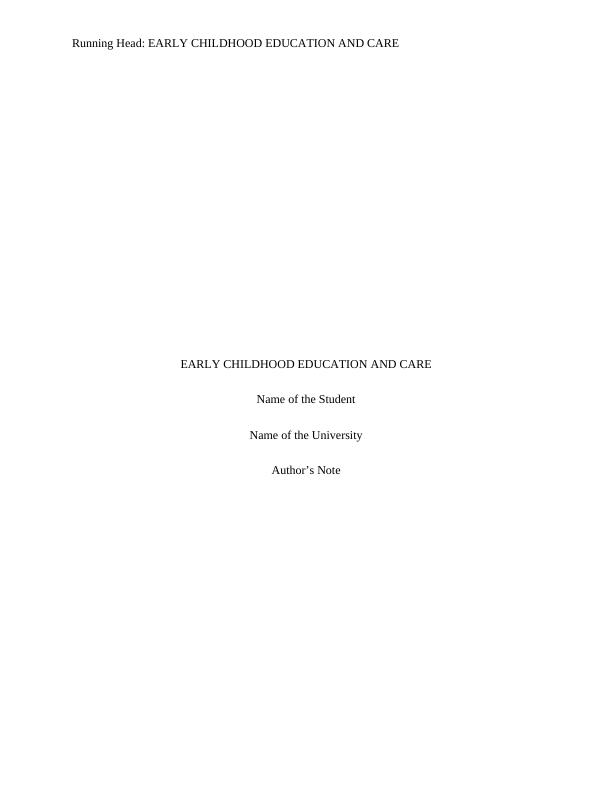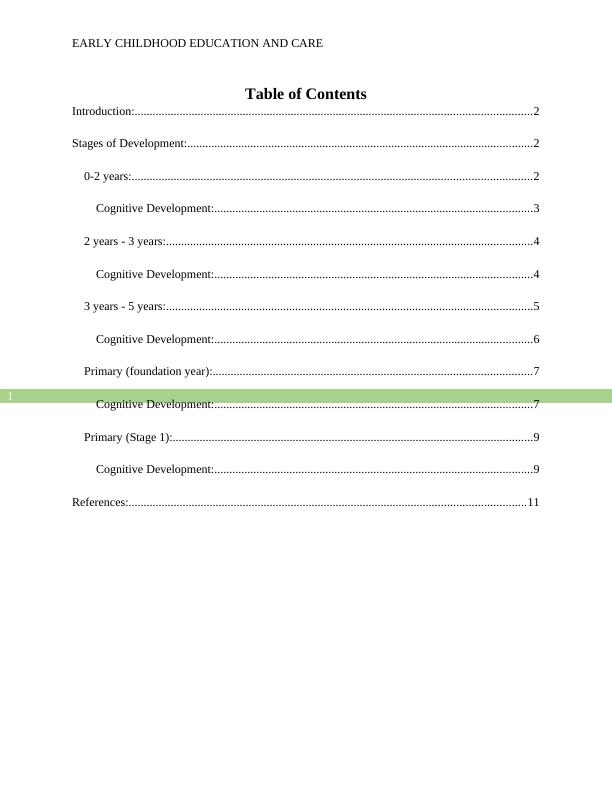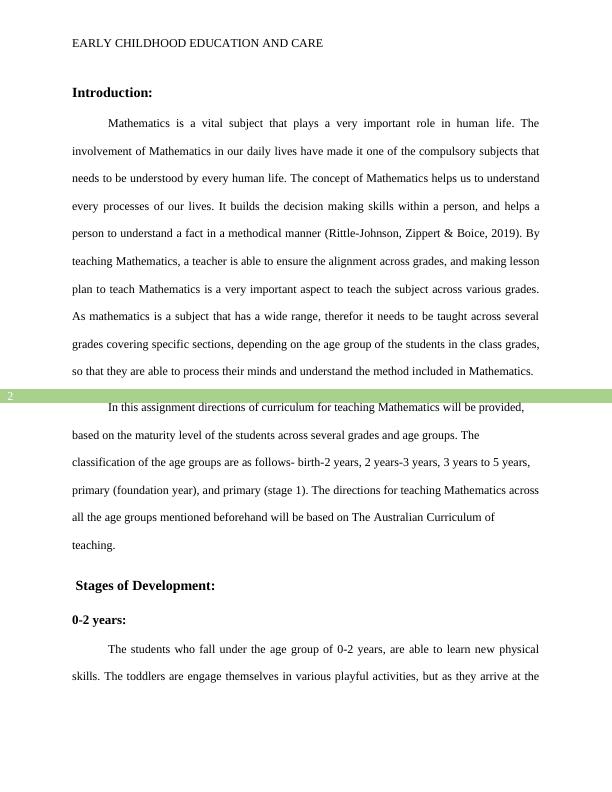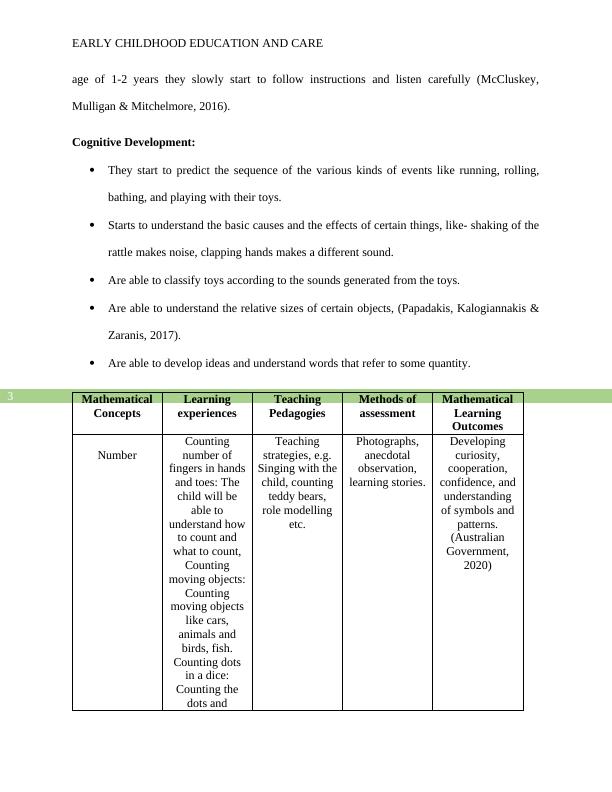Teaching Mathematics | Early Childhood Education and Care
Added on 2022-08-31
13 Pages2830 Words15 Views
Running Head: EARLY CHILDHOOD EDUCATION AND CARE
EARLY CHILDHOOD EDUCATION AND CARE
Name of the Student
Name of the University
Author’s Note
EARLY CHILDHOOD EDUCATION AND CARE
Name of the Student
Name of the University
Author’s Note

1
EARLY CHILDHOOD EDUCATION AND CARE
Table of Contents
Introduction:....................................................................................................................................2
Stages of Development:...................................................................................................................2
0-2 years:.....................................................................................................................................2
Cognitive Development:..........................................................................................................3
2 years - 3 years:..........................................................................................................................4
Cognitive Development:..........................................................................................................4
3 years - 5 years:..........................................................................................................................5
Cognitive Development:..........................................................................................................6
Primary (foundation year):..........................................................................................................7
Cognitive Development:..........................................................................................................7
Primary (Stage 1):........................................................................................................................9
Cognitive Development:..........................................................................................................9
References:....................................................................................................................................11
EARLY CHILDHOOD EDUCATION AND CARE
Table of Contents
Introduction:....................................................................................................................................2
Stages of Development:...................................................................................................................2
0-2 years:.....................................................................................................................................2
Cognitive Development:..........................................................................................................3
2 years - 3 years:..........................................................................................................................4
Cognitive Development:..........................................................................................................4
3 years - 5 years:..........................................................................................................................5
Cognitive Development:..........................................................................................................6
Primary (foundation year):..........................................................................................................7
Cognitive Development:..........................................................................................................7
Primary (Stage 1):........................................................................................................................9
Cognitive Development:..........................................................................................................9
References:....................................................................................................................................11

2
EARLY CHILDHOOD EDUCATION AND CARE
Introduction:
Mathematics is a vital subject that plays a very important role in human life. The
involvement of Mathematics in our daily lives have made it one of the compulsory subjects that
needs to be understood by every human life. The concept of Mathematics helps us to understand
every processes of our lives. It builds the decision making skills within a person, and helps a
person to understand a fact in a methodical manner (Rittle-Johnson, Zippert & Boice, 2019). By
teaching Mathematics, a teacher is able to ensure the alignment across grades, and making lesson
plan to teach Mathematics is a very important aspect to teach the subject across various grades.
As mathematics is a subject that has a wide range, therefor it needs to be taught across several
grades covering specific sections, depending on the age group of the students in the class grades,
so that they are able to process their minds and understand the method included in Mathematics.
In this assignment directions of curriculum for teaching Mathematics will be provided,
based on the maturity level of the students across several grades and age groups. The
classification of the age groups are as follows- birth-2 years, 2 years-3 years, 3 years to 5 years,
primary (foundation year), and primary (stage 1). The directions for teaching Mathematics across
all the age groups mentioned beforehand will be based on The Australian Curriculum of
teaching.
Stages of Development:
0-2 years:
The students who fall under the age group of 0-2 years, are able to learn new physical
skills. The toddlers are engage themselves in various playful activities, but as they arrive at the
EARLY CHILDHOOD EDUCATION AND CARE
Introduction:
Mathematics is a vital subject that plays a very important role in human life. The
involvement of Mathematics in our daily lives have made it one of the compulsory subjects that
needs to be understood by every human life. The concept of Mathematics helps us to understand
every processes of our lives. It builds the decision making skills within a person, and helps a
person to understand a fact in a methodical manner (Rittle-Johnson, Zippert & Boice, 2019). By
teaching Mathematics, a teacher is able to ensure the alignment across grades, and making lesson
plan to teach Mathematics is a very important aspect to teach the subject across various grades.
As mathematics is a subject that has a wide range, therefor it needs to be taught across several
grades covering specific sections, depending on the age group of the students in the class grades,
so that they are able to process their minds and understand the method included in Mathematics.
In this assignment directions of curriculum for teaching Mathematics will be provided,
based on the maturity level of the students across several grades and age groups. The
classification of the age groups are as follows- birth-2 years, 2 years-3 years, 3 years to 5 years,
primary (foundation year), and primary (stage 1). The directions for teaching Mathematics across
all the age groups mentioned beforehand will be based on The Australian Curriculum of
teaching.
Stages of Development:
0-2 years:
The students who fall under the age group of 0-2 years, are able to learn new physical
skills. The toddlers are engage themselves in various playful activities, but as they arrive at the

3
EARLY CHILDHOOD EDUCATION AND CARE
age of 1-2 years they slowly start to follow instructions and listen carefully (McCluskey,
Mulligan & Mitchelmore, 2016).
Cognitive Development:
They start to predict the sequence of the various kinds of events like running, rolling,
bathing, and playing with their toys.
Starts to understand the basic causes and the effects of certain things, like- shaking of the
rattle makes noise, clapping hands makes a different sound.
Are able to classify toys according to the sounds generated from the toys.
Are able to understand the relative sizes of certain objects, (Papadakis, Kalogiannakis &
Zaranis, 2017).
Are able to develop ideas and understand words that refer to some quantity.
Mathematical
Concepts
Learning
experiences
Teaching
Pedagogies
Methods of
assessment
Mathematical
Learning
Outcomes
Number
Counting
number of
fingers in hands
and toes: The
child will be
able to
understand how
to count and
what to count,
Counting
moving objects:
Counting
moving objects
like cars,
animals and
birds, fish.
Counting dots
in a dice:
Counting the
dots and
Teaching
strategies, e.g.
Singing with the
child, counting
teddy bears,
role modelling
etc.
Photographs,
anecdotal
observation,
learning stories.
Developing
curiosity,
cooperation,
confidence, and
understanding
of symbols and
patterns.
(Australian
Government,
2020)
EARLY CHILDHOOD EDUCATION AND CARE
age of 1-2 years they slowly start to follow instructions and listen carefully (McCluskey,
Mulligan & Mitchelmore, 2016).
Cognitive Development:
They start to predict the sequence of the various kinds of events like running, rolling,
bathing, and playing with their toys.
Starts to understand the basic causes and the effects of certain things, like- shaking of the
rattle makes noise, clapping hands makes a different sound.
Are able to classify toys according to the sounds generated from the toys.
Are able to understand the relative sizes of certain objects, (Papadakis, Kalogiannakis &
Zaranis, 2017).
Are able to develop ideas and understand words that refer to some quantity.
Mathematical
Concepts
Learning
experiences
Teaching
Pedagogies
Methods of
assessment
Mathematical
Learning
Outcomes
Number
Counting
number of
fingers in hands
and toes: The
child will be
able to
understand how
to count and
what to count,
Counting
moving objects:
Counting
moving objects
like cars,
animals and
birds, fish.
Counting dots
in a dice:
Counting the
dots and
Teaching
strategies, e.g.
Singing with the
child, counting
teddy bears,
role modelling
etc.
Photographs,
anecdotal
observation,
learning stories.
Developing
curiosity,
cooperation,
confidence, and
understanding
of symbols and
patterns.
(Australian
Government,
2020)

End of preview
Want to access all the pages? Upload your documents or become a member.
Related Documents
Curriculum Studies: Teaching Mathematics and EC Numeracy Learning Kitlg...
|25
|3343
|319
Child Development and Early Learning - Reportlg...
|11
|2831
|55
Personal Philosophy of Early Childhood Educationlg...
|5
|815
|77
Australian Curriculum for Number and Place Value for Foundation Level, Year 1, and Year 2lg...
|12
|2160
|193
MATHEMATICS IN EARLY CHILDHOOD EDUCATION.lg...
|18
|3558
|91
Mathematical Thinking: Assignmentlg...
|15
|2572
|120